Fluorescent Nanodiamonds for High-Resolution Thermometry in Biology
Abstract
:1. Introduction
2. Fluorescent Nanodiamonds
2.1. Structure of Nanodiamonds
2.2. Thermometry with Nitrogen-Vacancy Centers
2.3. Thermometry with Silicon-Vacancy Centers
2.4. Thermometry with Germanium-Vacancy Centers
3. Discussion of Possible Limits
4. Conclusions
Funding
Data Availability Statement
Conflicts of Interest
References
- Balaban, R.S. How hot are single cells? J. Gen. Physiol. 2020, 152, e202012629. [Google Scholar] [CrossRef] [PubMed]
- Ahl, D.; Eriksson, O.; Sedin, J.; Seignez, C.; Schwan, E.; Kreuger, J.; Christoffersson, G.; Phillipson, M. Turning Up the Heat: Local Temperature Control During in vivo Imaging of Immune Cells. Front. Immunol. 2019, 10, 2036. [Google Scholar] [CrossRef]
- Shi, H.; Sadler, P.J. How promising is phototherapy for cancer? Br. J. Cancer 2020, 123, 871–873. [Google Scholar] [CrossRef]
- Far, L.D.; Dramićanin, M.D. Luminescence Thermometry with Nanoparticles: A Review. Nanomaterials 2023, 13, 2904. [Google Scholar] [CrossRef]
- Peltek, O.O.; Ageev, E.I.; Talianov, P.M.; Mikushina, A.D.; Epifanovskaya, O.S.; Dubavik, A.; Veiko, V.P.; Lepik, K.; Zuev, D.A.; Timin, A.S.; et al. Fluorescence-based thermometry for precise estimation of nanoparticle laser-induced heating in cancerous cells at nanoscale. Nanophotonics 2022, 11, 4323–4335. [Google Scholar] [CrossRef]
- Zhou, J.; del Rosal, B.; Jaque, D.; Uchiyama, S.; Jin, D. Advances and challenges for fluorescence nanothermometry. Nat. Methods 2020, 17, 967–980. [Google Scholar] [CrossRef] [PubMed]
- Liu, G.; Lu, H. Laser-induced Fluorescence of Rhodamine B in Ethylene Glycol Solution. Procedia Eng. 2015, 102, 95–105. [Google Scholar] [CrossRef]
- Ogle, M.M.; Smith McWilliams, A.D.; Ware, M.J.; Curley, S.A.; Corr, S.J.; Martí, A.A. Sensing Temperature in Vitro and in Cells Using a BODIPY Molecular Probe. J. Phys. Chem. B 2019, 123, 7282–7289. [Google Scholar] [CrossRef]
- Yang, J.-M.; Yang, H.; Lin, L. Quantum Dot Nano Thermometers Reveal Heterogeneous Local Thermogenesis in Living Cells. ACS Nano 2011, 5, 5067–5071. [Google Scholar] [CrossRef]
- Zhang, B.; Guo, X.; Zhang, Z.; Fu, Z.; Zheng, H. Luminescence thermometry with rare earth doped nanoparticles: Status and challenges. J. Lumin. 2022, 250, 119110. [Google Scholar] [CrossRef]
- Alkahtani, M.H.; Alghannam, F.; Jiang, L.; Almethen, A.; Rampersaud, A.A.; Brick, R.; Gomes, C.L.; Scully, M.O.; Hemmer, P.R. Fluorescent nanodiamonds: Past, present, and future. Nanophotonics 2018, 7, 1423–1453. [Google Scholar] [CrossRef]
- Torelli, M.D.; Nunn, N.A.; Shenderova, O.A. A Perspective on Fluorescent Nanodiamond Bioimaging. Small 2019, 15, 1902151. [Google Scholar] [CrossRef] [PubMed]
- Tsou, C.-J.; Hsia, C.-H.; Chu, J.-Y.; Hung, Y.; Chen, Y.-P.; Chien, F.-C.; Chou, K.C.; Chen, P.; Mou, C.Y. Local pH tracking in living cells. Nanoscale 2015, 7, 4217–4225. [Google Scholar] [CrossRef] [PubMed]
- Su, D.; Teoh, C.L.; Gao, N.; Xu, Q.-H.; Chang, Y.-T. A Simple BODIPY-Based Viscosity Probe for Imaging of Cellular Viscosity in Live Cells. Sensors 2016, 16, 1397. [Google Scholar] [CrossRef] [PubMed]
- Schmid, A.; Kortmann, H.; Dittrich, P.S.; Blank, L.M. Chemical and biological single cell analysis. Curr. Opin. Bio-Technol. 2010, 21, 12–20. [Google Scholar] [CrossRef] [PubMed]
- Krishnakumar, S.; Gopidas, K.R. Covalent Functionalization of Organic Nanoparticles Using Aryl Diazonium Chemistry and Their Solvent-Dependent Self-Assembly. Langmuir 2017, 33, 1162–1170. [Google Scholar] [CrossRef] [PubMed]
- Demchenko, A.P. Photobleaching of organic fluorophores: Quantitative characterization, mechanisms, protection. Methods Appl. Fluoresc. 2020, 8, 022001. [Google Scholar] [CrossRef] [PubMed]
- Cui, P.; Jiang, X.; Sun, J.; Zhang, Q.; Gao, F. A water-soluble rhodamine B-derived fluorescent probe for pH monitoring and imaging in acidic regions. Methods Appl. Fluoresc. 2017, 5, 024009. [Google Scholar] [CrossRef] [PubMed]
- Foerster, A.; Besley, N.A. Quantum Chemical Characterization and Design of Quantum Dots for Sensing Applications. J. Phys. Chem. A 2022, 126, 2899–2908. [Google Scholar] [CrossRef] [PubMed]
- Probst, C.E.; Zrazhevskiy, P.; Bagalkot, V.; Gao, X. Quantum dots as a platform for nanoparticle drug delivery vehicle design. Adv. Drug Deliv. Rev. 2013, 65, 703–718. [Google Scholar] [CrossRef] [PubMed]
- Haupt, F.; Imamoglu, A.; Kroner, M. Single Quantum Dot as an Optical Thermometer for Millikelvin Temperatures. Phys. Rev. Appl. 2014, 2, 024001. [Google Scholar] [CrossRef]
- Hardman, R. A Toxicologic Review of Quantum Dots: Toxicity Depends on Physicochemical and Environmental Factors. Environ. Health Perspect. 2006, 114, 165–172. [Google Scholar] [CrossRef] [PubMed]
- Lidke, K.A.; Rieger, B.; Jovin, T.M.; Heintzmann, R. Superresolution by localization of quantum dots using blinking statistics. Opt. Express 2005, 13, 7052–7062. [Google Scholar] [CrossRef] [PubMed]
- Herrera-Ochoa, D.; Pacheco-Liñán, P.J.; Bravo, I.; Garzón-Ruiz, A. A Novel Quantum Dot-Based pH Probe for Long-Term Fluorescence Lifetime Imaging Microscopy Experiments in Living Cells. ACS Appl. Mater. Interfaces 2022, 14, 2578–2586. [Google Scholar] [CrossRef] [PubMed]
- Liu, X.; Skripka, A.; Lai, Y.; Jiang, C.; Liu, J.; Vetrone, F.; Liang, J. Fast wide-field upconversion luminescence lifetime thermometry enabled by single-shot compressed ultrahigh-speed imaging. Nat. Commun. 2021, 12, 6401. [Google Scholar] [CrossRef] [PubMed]
- Wang, C.; He, M.; Chen, B.; Hu, B. Study on cytotoxicity, cellular uptake and elimination of rare-earth-doped upconversion nanoparticles in human hepatocellular carcinoma cells. Ecotoxicol. Environ. Saf. 2020, 203, 110951. [Google Scholar] [CrossRef] [PubMed]
- Hao, S.; Chen, G.; Yang, C. Sensing Using Rare-Earth-Doped Upconversion Nanoparticles. Theranostics 2013, 3, 331–345. [Google Scholar] [CrossRef] [PubMed]
- Chrétien, D.; Bénit, P.; Ha, H.-H.; Keipert, S.; El-Khoury, R.; Chang, Y.-T.; Jastroch, M.; Jacobs, H.T.; Rustin, P.; Rak, M. Mitochondria are physiologically maintained at close to 50 °C. PLoS Biol. 2018, 16, e2003992. [Google Scholar] [CrossRef] [PubMed]
- Moreno-Loshuertos, R.; Marco-Brualla, J.; Meade, P.; Soler-Agesta, R.; Enriquez, J.A.; Fernández-Silva, P. How hot can mi-tochondria be? Incubation at temperatures above 43 °C induces the degradation of respiratory complexes and supercomplexes in intact cells and isolated mitochondria. Mitochondrion 2023, 69, 83–94. [Google Scholar] [CrossRef] [PubMed]
- Bradac, C.; Gaebel, T.; Naidoo, N.; Rabeau, J.R.; Barnard, A.S. Prediction and Measurement of the Size-Dependent Stability of Fluorescence in Diamond over the Entire Nanoscale. Nano Lett. 2009, 9, 3555–3564. [Google Scholar] [CrossRef] [PubMed]
- Schrand, A.M.; Huang, H.; Carlson, C.; Schlager, J.J.; Ōsawa, E.; Hussain, S.M.; Dai, L. Are Diamond Nano-particles Cytotoxic? J. Phys. Chem. B 2007, 111, 2–7. [Google Scholar] [CrossRef] [PubMed]
- Jung, H.-S.; Neuman, K.C. Surface Modification of Fluorescent Nanodiamonds for Biological Applications. Nanomaterials 2021, 11, 153. [Google Scholar] [CrossRef] [PubMed]
- Wu, Y.; Weil, T. Nanodiamonds for Biological Applications. Phys. Sci. Rev. 2017, 2, 20160104. [Google Scholar]
- Wu, Y.; Ermakova, A.; Liu, W.; Pramanik, G.; Vu, M.; Kurz, A.; McGuinness, L.; Naydenov, B.; Hafner, S.; Reuter, R.; et al. Programmable Biopolymers for Advancing Biomedical Applications of Fluorescent Nanodiamonds. Adv. Funct. Mater. 2015, 25, 6576–6585. [Google Scholar] [CrossRef]
- Chauhan, S.; Jain, N.; Nagaich, U. Nanodiamonds with powerful ability for drug delivery and biomedical ap-plications: Recent updates on in vivo study and patents. J. Pharm. Anal. 2020, 10, 1–12. [Google Scholar] [CrossRef] [PubMed]
- Fujiwara, M.; Shikano, Y. Diamond quantum thermometry: From foundations to applications. Nanotechnology 2021, 32, 482002. [Google Scholar] [CrossRef] [PubMed]
- Hauf, M.V.; Grotz, B.; Naydenov, B.; Dankerl, M.; Pezzagna, S.; Meijer, J.; Jelezko, F.; Wrachtrup, J.; Stutzmann, M.; Reinhard, F.; et al. Chemical control of the charge state of nitrogen-vacancy centers in diamond. Phys. Rev. B 2011, 83, 081304(R). [Google Scholar] [CrossRef]
- Stehlik, S.; Ondic, L.; Varga, M.; Fait, J.; Artemenko, A.; Glatzel, T.; Kromka, A.; Rezek, B. Silicon-Vacancy Centers in Ultra-Thin Nanocrystalline Diamond Films. Micromachines 2018, 9, 281. [Google Scholar] [CrossRef] [PubMed]
- Hui, Y.Y.; Chen, O.Y.; Azuma, T.; Chang, B.-M.; Hsieh, F.-J.; Chang, H.-C. All-Optical Thermometry with Nitrogen-Vacancy Centers in Nanodiamond-Embedded Polymer Films. J. Phys. Chem. C 2019, 123, 15366–15374. [Google Scholar] [CrossRef]
- Pedroza-Montero, F.; Santacruz-Gómez, K.; Acosta-Elías, M.; Silva-Campa, E.; Meza-Figueroa, D.; Soto-Puebla, D.; Castaneda, B.; Urrutia-Bañuelos, E.; Álvarez-Bajo, O.; Navarro-Espinoza, S.; et al. Thermometric Characterization of Fluorescent Nanodiamonds Suitable for Biomedical Applications. Appl. Sci. 2021, 11, 4065. [Google Scholar] [CrossRef]
- Tsai, P.-C.; Epperla, C.P.; Huang, J.-S.; Chen, O.Y.; Wu, C.-C.; Chang, H.-C. Measuring Nanoscale Thermostability of Cell Membranes with Single Gold–Diamond Nanohybrids. Angew. Chem. Int. Ed. 2017, 56, 3025–3030. [Google Scholar] [CrossRef] [PubMed]
- Wu, T.; Chen, X.; Gong, Z.; Yan, J.; Guo, J.; Zhang, Y.; Li, Y.; Li, B. Intracellular Thermal Probing Using Aggregated Fluorescent Nanodiamonds. Adv. Sci. 2022, 9, 2103354. [Google Scholar] [CrossRef] [PubMed]
- Plakhotnik, T.; Aman, H.; Chang, H.-C. All-optical single-nanoparticle ratiometric thermometry with a noise floor of 0.3 K Hz−1/2. Nanotechnology 2015, 2, 245501. [Google Scholar] [CrossRef] [PubMed]
- Neumann, P.; Jakobi, I.; Dolde, F.; Burk, C.; Reuter, R.; Waldherr, G.; Honert, J.; Wolf†, T.; Brunner, A.; Shim, J.H.; et al. High-Precision Nanoscale Temperature Sensing Using Single Defects in Diamond. Nano Lett. 2013, 13, 2738–2742. [Google Scholar] [CrossRef] [PubMed]
- Kucsko, G.; Maurer, P.C.; Yao, N.Y.; Kubo, M.; Noh, H.J.; Lo, P.K.; Park, H.; Lukin, M.D. Nanometre-scale thermometry in a living cell. Nature 2013, 500, 54–58. [Google Scholar] [CrossRef] [PubMed]
- Nishimura, Y.; Oshimi, K.; Umehara, Y.; Kumon, Y.; Miyaji, K.; Yukawa, H.; Shikano, Y.; Matsubara, T.; Fujiwara, M.; Baba, Y.; et al. Wide-field fluorescent nanodiamond spin measurements toward real-time large-area intracellular thermometry. Sci. Rep. 2021, 11, 4248. [Google Scholar] [CrossRef] [PubMed]
- Sekiguchi, T.; Sotoma, S.; Harada, Y. Fluorescent nanodiamonds as a robust temperature sensor inside a single cell. Biophys. Physicobiol. 2018, 15, 229–234. [Google Scholar] [CrossRef] [PubMed]
- Petrini, G.; Tomagra, G.; Bernardi, E.; Moreva, E.; Traina, P.; Marcantoni, A.; Picollo, F.; Kvaková, K.; Cígler, P.; Degiovanni, I.P.; et al. Nanodiamond–Quantum Sensors Reveal Temperature Variation Associated to Hippocampal Neurons Firing. Adv. Sci. 2022, 9, 220214. [Google Scholar] [CrossRef] [PubMed]
- Lanin, A.A.; Fedotov, I.V.; Ermakova, Y.G.; Sidorov-Biryukov, D.A.; Fedotov, A.B.; Hemmer, P.; Belousov, V.V.; Zheltikov, A.M. Fiber-optic electron-spin-resonance thermometry of single laser-activated neurons. Opt. Lett. 2016, 41, 5563–5566. [Google Scholar] [CrossRef] [PubMed]
- Fujiwara, M.; Sun, S.; Dohms, A.; Nishimura, Y.; Suto, K.; Takezawa, Y.; Oshimi, K.; Zhao, L.; Sadzak, N.; Umehara, Y.; et al. Real-time nanodiamond thermometry probing in vivo thermogenic responses. Sci. Adv. 2020, 6, eaba9636. [Google Scholar] [CrossRef] [PubMed]
- So, F.T.-K.; Hariki, N.; Nemoto, M.; Shames, A.I.; Liu, M.; Tsurui, A.; Yoshikawa, T.; Makino, Y.; Ohori, M.; Fujiwara, M.; et al. Small multimodal thermometry with detonation-created multi-color centers in detonation nanodiamond. APL Mater. 2024, 12, 051102. [Google Scholar] [CrossRef]
- Nguyen, C.T.; Evans, R.E.; Sipahigil, A.; Bhaskar, M.K.; Sukachev, D.D.; Agafonov, V.N.; Davydov, V.A.; Kulikova, L.K.; Jelezko, F.; Lukin, M.D. All-optical nanoscale thermometry with silicon-vacancy centers in diamond. Appl. Phys. Lett. 2018, 112, 203102. [Google Scholar] [CrossRef]
- Liu, W.; Alam, M.N.A.; Liu, Y.; Agafonov, V.N.; Qi, H.; Koynov, K.; Davydov, V.A.; Uzbekov, R.; Kaiser, U.; Lasser, T.; et al. Silicon-Vacancy Nanodiamonds as High Performance Near-Infrared Emitters for Live-Cell Dual-Color Imaging and Thermometry. Nano Lett. 2022, 22, 2881–2888. [Google Scholar] [CrossRef] [PubMed]
- Romshin, A.M.; Zeeb, V.; Martyanov, A.K.; Kudryavtsev, O.S.; Pasternak, D.G.; Sedov, V.S.; Ralchenko, V.G.; Sinogeykin, A.G.; Vlasov, I.I. A new approach to precise mapping of local temperature fields in submicrometer aqueous volumes. Sci. Rep. 2021, 11, 14228. [Google Scholar] [CrossRef] [PubMed]
- Romshin, A.M.; Osypov, A.A.; Popova, I.Y.; Zeeb, V.E.; Sinogeykin, A.G.; Vlasov, I.I. Heat Release by Isolated Mouse Brain Mi-tochondria Detected with Diamond Thermometer. Nanomaterials 2023, 13, 98. [Google Scholar] [CrossRef] [PubMed]
- Fan, J.-W.; Cojocaru, I.; Becker, J.; Fedotov, I.V.; Alkahtani, M.H.A.; Alajlan, A.; Blakley, S.; Rezaee, M.; Lyamkina, A.; Palyanov, Y.N.; et al. Germanium-Vacancy Color Center in Diamond as a Temperature Sensor. ACS Photonics 2018, 5, 765–770. [Google Scholar] [CrossRef]
- Fujiwara, M.; Fu, H.; Hariki, N.; Ohki, I.; Makino, Y.; Liu, M.; Tsurui, A.; Yoshikawa, T.; Nishikawa, M.; Mizuochi, N. Germa-nium-vacancy centers in detonation nanodiamond for all-optical nanoscale thermometry. Appl. Phys. Lett. 2023, 123, 181903. [Google Scholar] [CrossRef]
- Shenderova, O.A.; Shames, A.I.; Nunn, N.A.; Torelli, M.D.; Vlasov, I.; Zaitsev, A. Review Article: Synthesis, properties, and applications of fluorescent diamond particles. J. Vac. Sci. Technol. B 2019, 37, 030802. [Google Scholar] [CrossRef] [PubMed]
- Qin, J.-X.; Yang, X.-G.; Lv, C.-F.; Li, Y.-Z.; Liu, K.-K.; Zang, J.-H.; Yang, X.; Dong, L.; Shan, C.-X. Nanodiamonds: Synthesis, properties, and applications in nanomedicine. Mater. Des. 2021, 210, 110091. [Google Scholar] [CrossRef]
- Pezzagna, S.; Rogalla, D.; Wildanger, D.; Meijer, J.; Zaitsev, A. Creation and nature of optical centres in diamond for single-photon emission—Overview and critical remarks. New J. Phys. 2011, 13, 035024. [Google Scholar] [CrossRef]
- Sahoo, S.; Davydov, V.; Agafonov, V.; Bogdanov, S.I. Hybrid quantum nanophotonic devices with color centers in nanodiamonds. arXiv 2022, arXiv:2207.12340. [Google Scholar] [CrossRef]
- Garifo, S.; Stanicki, D.; Ayata, G.; Muller, R.N.; Laurent, S. Nanodiamonds as nanomaterial for biomedical field. Front. Mater. Sci. 2021, 15, 334–351. [Google Scholar] [CrossRef]
- Saoudi, L.; Girard, H.A.; Larquet, E.; Mermoux, M.; Leroy, J.; Arnault, J.-C. Colloidal stability over months of highly crystalline high-pressure high-temperature hydrogenated nanodiamonds in water. Carbon 2023, 200, 438–449. [Google Scholar] [CrossRef]
- D’Haenens-Johansson, U.F.S.; Butler, J.E.; Katrusha, A.N. Synthesis of Diamonds and Their Identification. Rev. Miner. Geochem. 2022, 88, 689–754. [Google Scholar] [CrossRef]
- Schrand, A.M.; Hens, S.A.C.; Shenderova, O.A. Nanodiamond Particles: Properties and Perspectives for Bioapplications. Crit. Rev. Solid State Mater. Sci. 2009, 34, 18–74. [Google Scholar] [CrossRef]
- Butler, J.E.; Sumant, A.V. The CVD of Nanodiamond Materials. Chem. Vap. Depos. 2008, 14, 145–160. [Google Scholar] [CrossRef]
- Bogdanov, K.V.; Baranov, M.A.; Feoktistov, N.A.; Kaliya, I.E.; Golubev, V.G.; Grudinkin, S.A.; Baranov, A.V. Duo Emission of CVD Nanodiamonds Doped by SiV and GeV Color Centers: Effects of Growth Conditions. Materials 2022, 15, 3589. [Google Scholar] [CrossRef] [PubMed]
- Crane, M.J.; Petrone, A.; Beck, R.A.; Lim, M.B.; Zhouu, X.; Li, X.; Stroud, R.M.; Pauzauskie, P.J. High-pressure, high-temperature molecular doping of nanodiamond. Sci. Adv. 2019, 5, aau6073. [Google Scholar] [CrossRef] [PubMed]
- Ekimov, E.A.; Kudryavtsev, O.S.; Mordvinova, N.E.; Lebedev, O.I.; Vlasov, I.I. High-Pressure Synthesis of Nanodiamonds from Adamantane: Myth or Reality? ChenNanoMat 2018, 4, 269–273. [Google Scholar] [CrossRef]
- Liang, X.; Ender, C.P.; Zapata, T.; Ermakova, A.; Wagner, M.; Weil, T. Germanium iodide mediated synthesis of nanodiamonds from adamantane “seeds” under moderate high-pressure high-temperature conditions. Diam. Relat. Mater. 2020, 108, 108000. [Google Scholar] [CrossRef]
- Plakhotnik, T.; Duka, T.; Davydov, V.A.; Agafonov, V.N. Formation of SiV centers by doping in bottom-up grown HPHT nanodiamonds and its implication for optical nanosensig. Diam. Relat. Mater. 2023, 139, 110363. [Google Scholar] [CrossRef]
- Bogdanov, D.; Bogdanov, A.; Plotnikov, V.; Makarov, S.; Yelisseyev, A.; Chepurov, A. Core growth of detonation nanodiamonds under high-pressure annealing. RSC Adv. 2021, 11, 12961–12970. [Google Scholar] [CrossRef]
- de Feudis, M.; Tallaire, A.; Nicolas, L.; Brinza, O.; Goldner, P.; Hétet, G.; Bénédic, F.J.; Achard, J. Large scale fabrication of highly emissive nanodiamonds by chemical vapor deposition with controlled doping by SiV and GeV centers from a solid source. Adv. Mater. Interfaces 2020, 7, 1901408. [Google Scholar] [CrossRef]
- Prooth, J.; Petrov, M.; Shmakova, A.; Gulka, M.; Cigler, P.; D’Haen, J.; Boyen, H.-G.; Nesladek, M. Long Spin Relaxation Times in CVD-Grown Nanodiamonds. Adv. Quantum Technol. 2023, 6, 2300004. [Google Scholar] [CrossRef]
- Karaveli, S.; Gaathon, O.; Wolcott, A.; Sakakibara, R.; Shemesh, O.A.; Peterka, D.S.; Boyden, E.S.; Owen, J.S.; Yuste, R.; Englund, D. Modulation of nitrogen vacancy charge state and fluorescence in nanodiamonds using electrochemical potential. Appl. Phys. Sci. 2016, 113, 3938–3943. [Google Scholar] [CrossRef] [PubMed]
- Bernien, H.; Childress, L.; Robledo, L.; Markham, M.; Twitchen, D.; Hanson, R. Two-Photon Quantum Interference from Separate Nitrogen Vacancy Centers in Diamond. Phys. Rev. Lett. 2012, 108, 043604. [Google Scholar] [CrossRef] [PubMed]
- Ermakova, A.; Pramanik, G.; Cai, J.-M.; Algara-Siller, G.; Kaiser, U.; Weil, T.; Tzeng, Y.-K.; Chang, H.C.; McGuinness, L.P.; Plenio, M.B.; et al. Detection of a Few Metallo-Protein Molecules Using Color Centers in Nanodiamonds. Nano Lett. 2013, 13, 3305–3309. [Google Scholar] [CrossRef] [PubMed]
- Barton, J.; Gulka, M.; Tarabek, J.; Mindarava, Y.; Wang, Z.; Schimer, J.; Raabova, H.; Bednar, J.; Plenio, M.B.; Jelezko, F.; et al. Nanoscale Dynamic Readout of a Chemical Redox Process Using Radicals Coupled with Nitrogen-Vacancy Centers in Nanodiamonds. ACS Nano 2020, 14, 12938–12950. [Google Scholar] [CrossRef] [PubMed]
- Martínez, F.P.; Nusantara, A.C.; Chipaux, M.; Padamati, S.K.; Schirhagl, R. Nanodiamond Relaxometry-Based Detection of Free-Radical Species When Produced in Chemical Reactions in Biologically Relevant Conditions. ACS Sens. 2020, 5, 3862–3869. [Google Scholar] [CrossRef] [PubMed]
- Mamin, H.J.; Kim, M.; Sherwood, M.H.; Rettner, C.T.; Ohno, K.; Awschalom, D.D.; Rugar, D. Nanoscale Nuclear Magnetic Resonance with a Nitrogen-Vacancy Spin Sensor. Science 2013, 339, 557–560. [Google Scholar] [CrossRef]
- Staudacher, T.; Shi, F.; Pezzagna, S.; Meijer, J.; Du, J.; Meriler, C.A.; Reinhard, F.; Wrachtrup, J. Nuclear Magnetic Resonance Spectroscopy on a (5-Nanometer)3 Sample Volume. Science 2013, 339, 561–563. [Google Scholar] [CrossRef] [PubMed]
- Acosta, V.M.; Bauch, E.; Ledbetter, M.P.; Waxman, A.; Bouchard, L.-S.; Budker, D. Temperature Dependence of the Nitrogen-Vacancy Magnetic Resonance in Diamond. Phys. Rev. Lett. 2010, 104, 070801. [Google Scholar] [CrossRef] [PubMed]
- Tian, Y.; Nusantara, A.C.; Hamoh, T.; Mzyk, A.; Tian, X.; Martinez, F.P.; Li, R.; Permentier, H.P.; Schirhagl, R. Functionalized Fluorescent Nanodiamonds for Simultaneous Drug Delivery and Quantum Sensing in HeLa Cells. ACS Appl. Mater. Interfaces 2022, 14, 39265–39273. [Google Scholar] [CrossRef] [PubMed]
- Wu, Y.; Alam, M.D.A.; Balasubramanian, P.; Ermakova, A.; Fischer, S.; Barth, H.; Wagner, M.; Raabe, M.; Jelezko, F.; Weil, T. Nanodiamond Theranostic for Light-Controlled Intracellular Heating and Nanoscale Temperature Sensing. Nano Lett. 2021, 21, 3780–3788. [Google Scholar] [CrossRef] [PubMed]
- Sevieri, M.; Silva, F.; Bonizzi, A.; Sitia, L.; Truffi, M.; Mazzucchelli, S.; Corsi, F. Indocyanine Green Nanoparticles: Are They Compelling for Cancer Treatment? Front. Chem. Sec. Nanosci. 2020, 8, 535. [Google Scholar] [CrossRef] [PubMed]
- Plank, J.R.; Morgan, C.; Sundram, F.; Plank, L.D.; Hoeh, N.; Ahn, S.; Muthukumaraswamy, S.; Lin, J.C. Brain temperature as an indicator of neuroinflammation induced by typhoid vaccine: Assessment using whole-brain magnetic resonance spectroscopy in a randomised crossover study. Neuroimage Clin. 2022, 35, 103053. [Google Scholar] [CrossRef] [PubMed]
- Yulug, B.; Velioglu, H.A.; Sayman, D.; Cankaya, S.; Hanoglu, L. Brain temperature in healthy and diseased conditions: A review on the special implications of MRS for monitoring brain temperature. Biomed. Pharmacother. 2023, 160, 114287. [Google Scholar] [CrossRef] [PubMed]
- Kim, T.; Kadji, H.; Whalen, A.J.; Ashourvan, A.; Freeman, E.; Fried, S.I.; Tadigadapa, S.; Schiff, S.J. Thermal effects on neurons during stimulation of the brain. J. Neural Eng. 2022, 19, 056029. [Google Scholar] [CrossRef]
- Rodríguez-Sevilla, P.; Marin, R.; Ximendes, E.; del Rosal, B.; Benayas, A.; Jaque, D. Luminescence Thermometry for Brain Activity Monitoring: A Perspective. Front. Chem. 2022, 10, 941861. [Google Scholar] [CrossRef]
- Talavera, K.; Nilius, B.; Voets, T. Neuronal TRP channels: Thermometers, pathfinders and life-savers. Trends Neurosci. 2008, 31, 287–295. [Google Scholar] [CrossRef] [PubMed]
- Neu, E.; Hepp, C.; Hauschild, M.; Gsell, S.; Fischer, M.; Sternschulte, H.; Steinmüller-Nethl, D.; Schreck, M.; Becher, C. Low-temperature investigations of single silicon vacancy colour centres in diamond. New J. Phys. 2013, 15, 043005. [Google Scholar] [CrossRef]
- Smith, A.M.; Mancini, M.C.; Nie, S. Second window for in vivo imaging. Nat. Nanotechnol. 2009, 4, 710–711. [Google Scholar] [CrossRef] [PubMed]
- Nahra, M.; Alshamaa, D.; Deturche, R.; Davydov, V.; Kulikova, L.; Agafonov, V.; Couteau, C. Single germanium vacancy centers in nanodiamonds with bulk-like spectral stability. AVS Quantum Sci. 2021, 3, 012001. [Google Scholar] [CrossRef]
- Joy, R.M.; Pobedinskas, P.; Bourgeois, E.; Chakraborty, T.; Görlitz, J.; Herrmann, D.; Noël, C.; Heupel, J.; Jannis, D.; Gauquelin, N.; et al. Germanium vacancy centre formation in CVD nanocrystalline diamond using a solid dopant source. Sci. Talks 2023, 5, 100157. [Google Scholar]
- Awadallah, A.; Zohar, I.; Finkler, A. Spin-strain coupling in nanodiamonds as a unique cluster identifier. J. Appl. Phys. 2023, 133, 145103. [Google Scholar] [CrossRef]
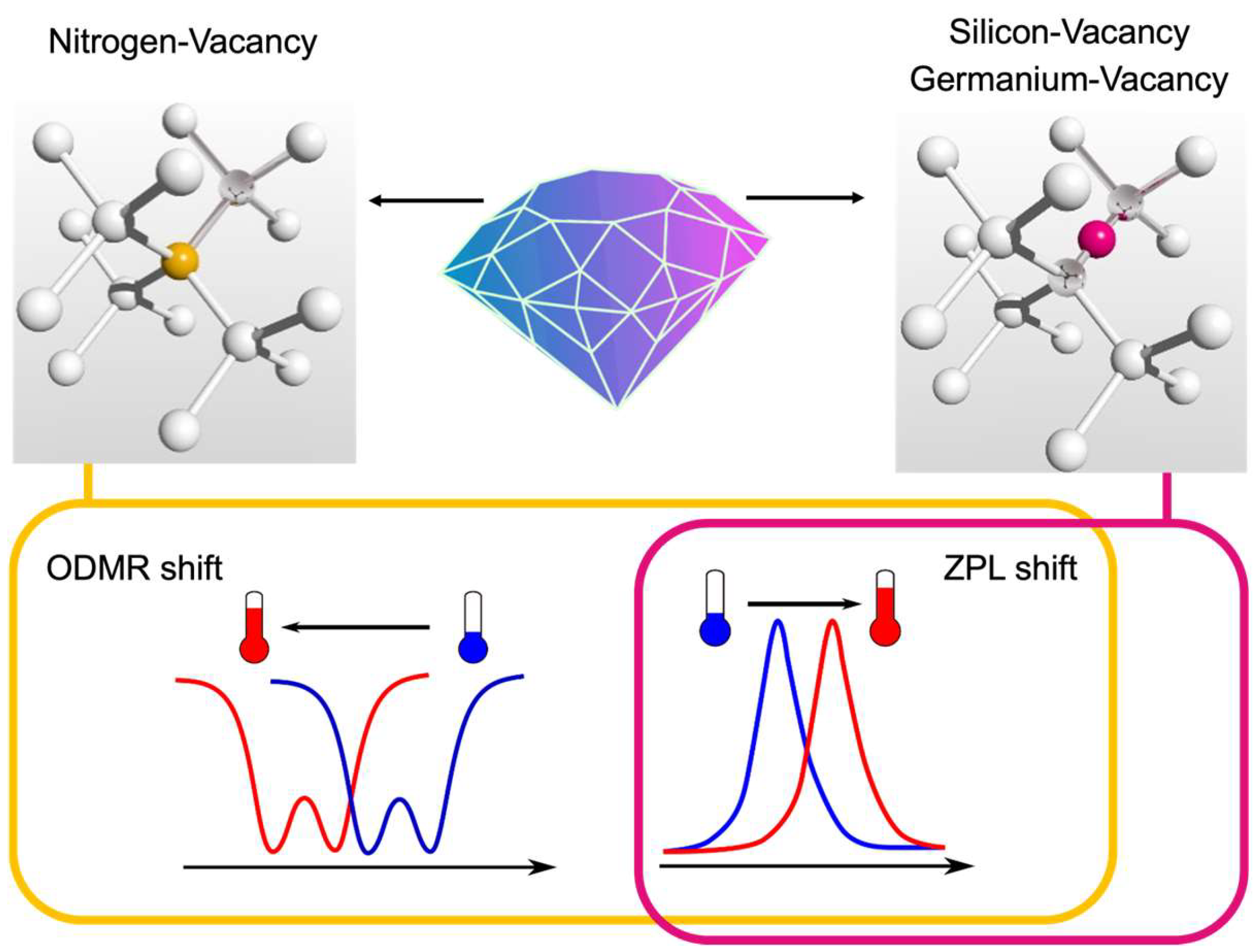

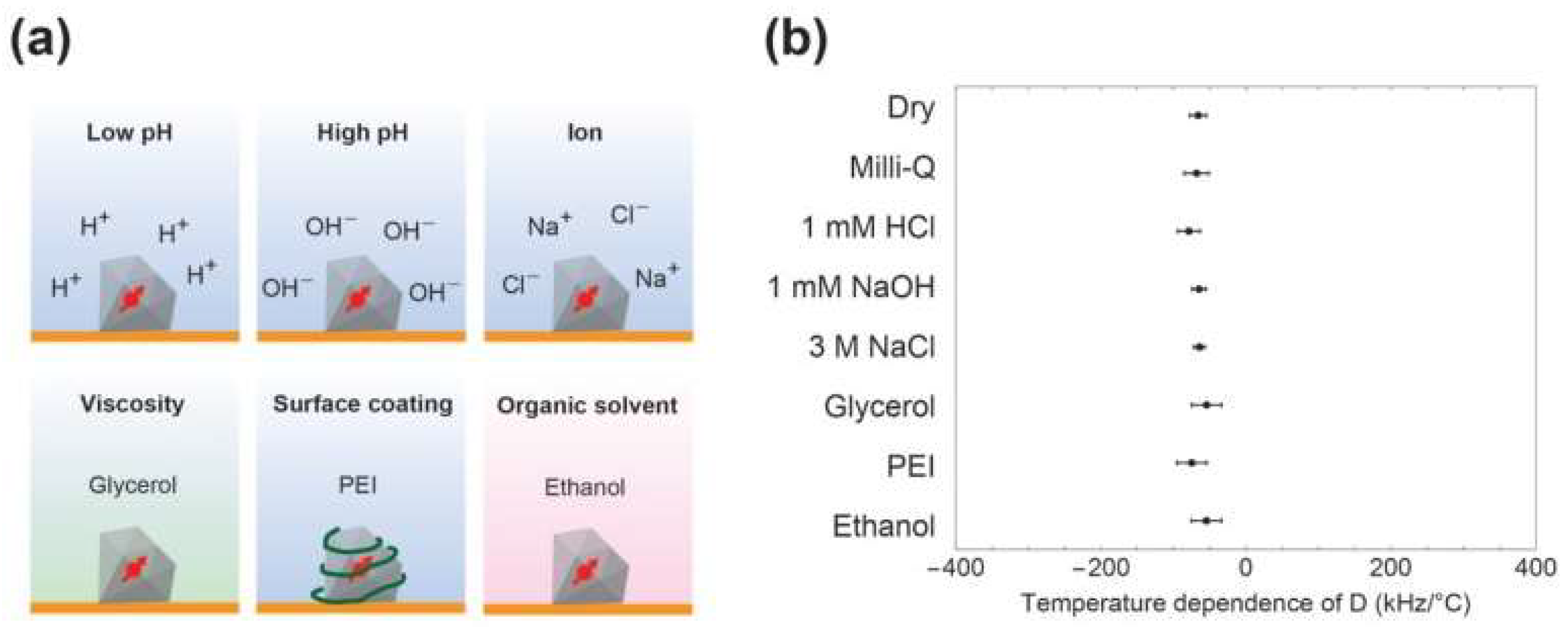
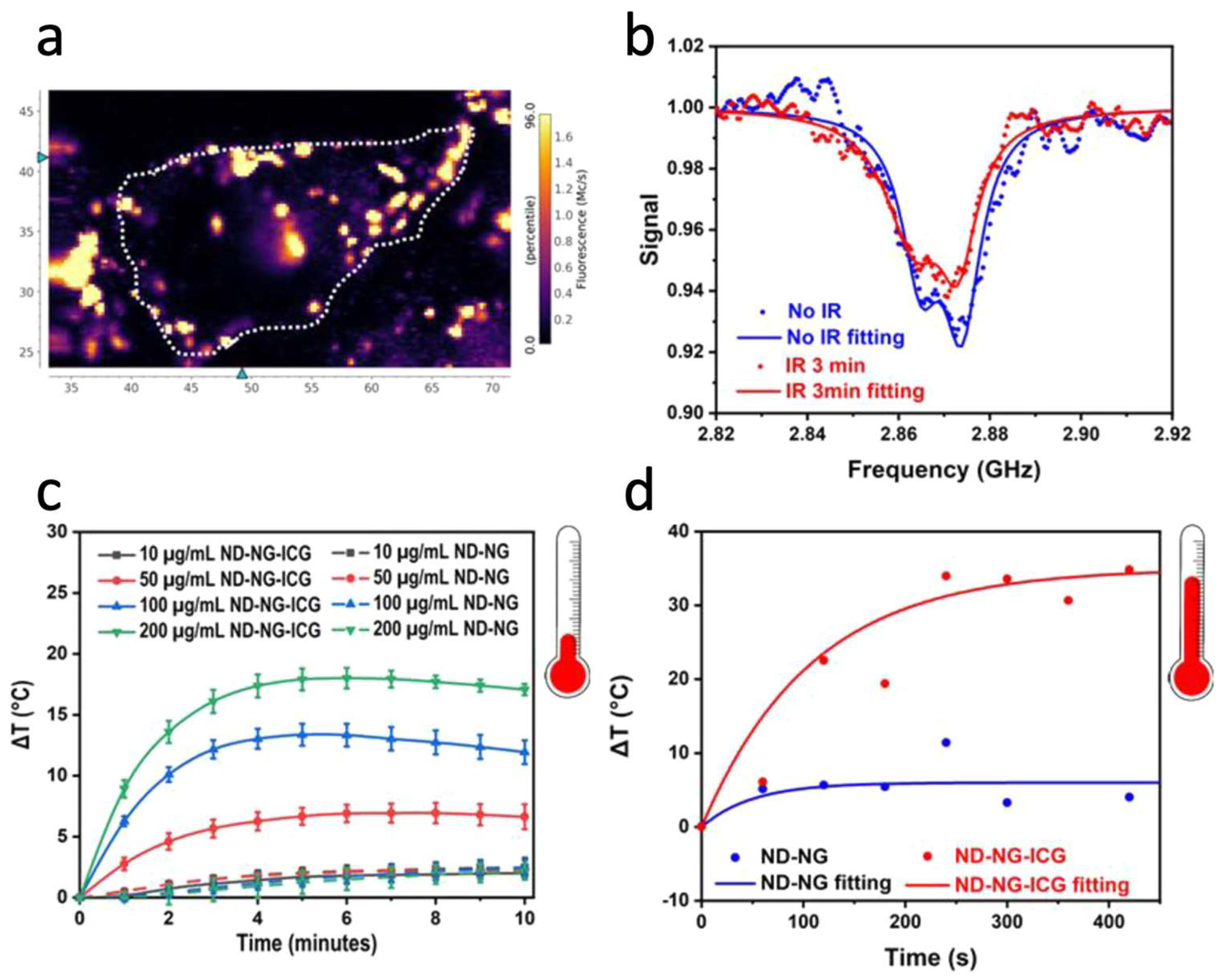
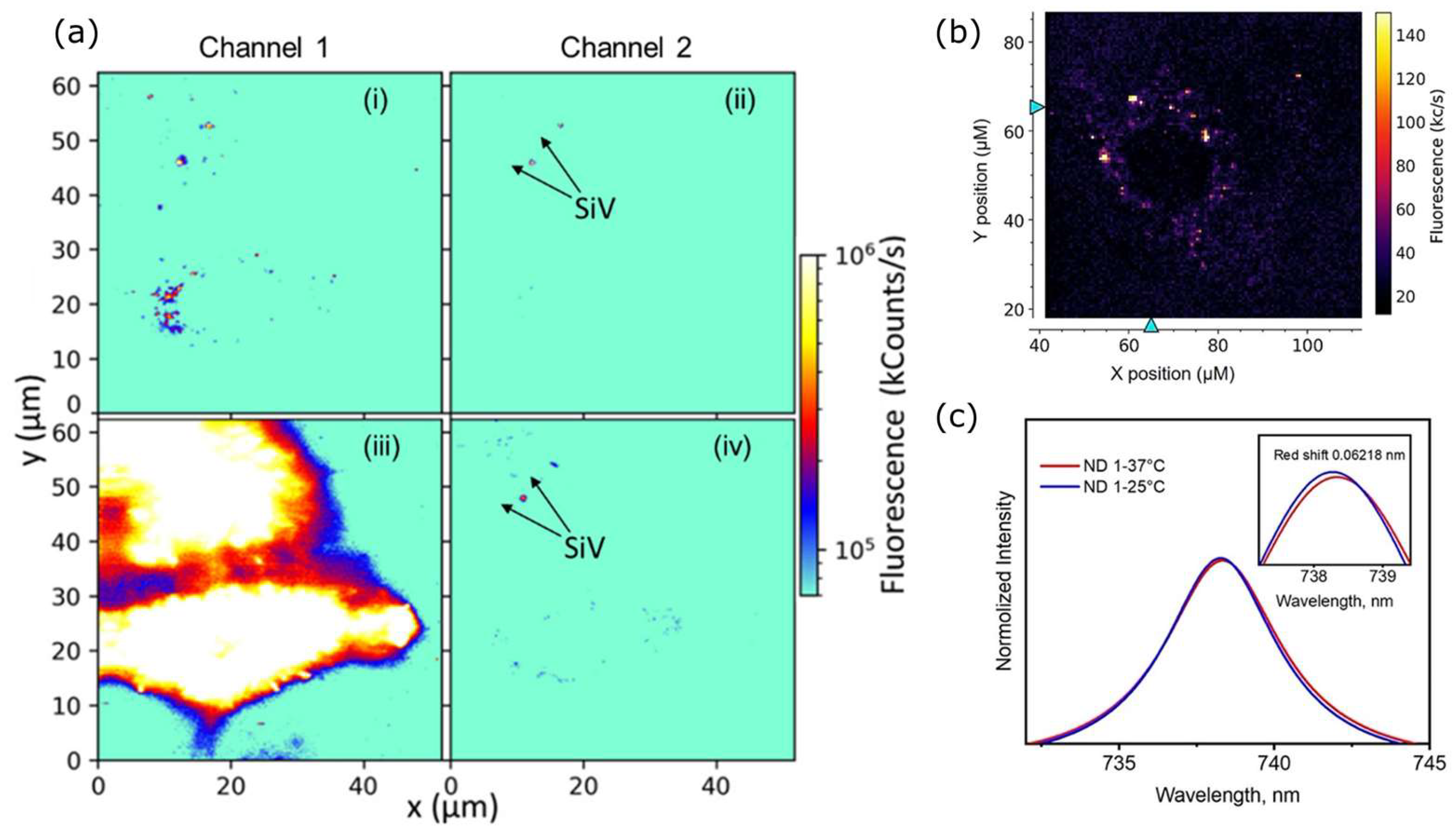
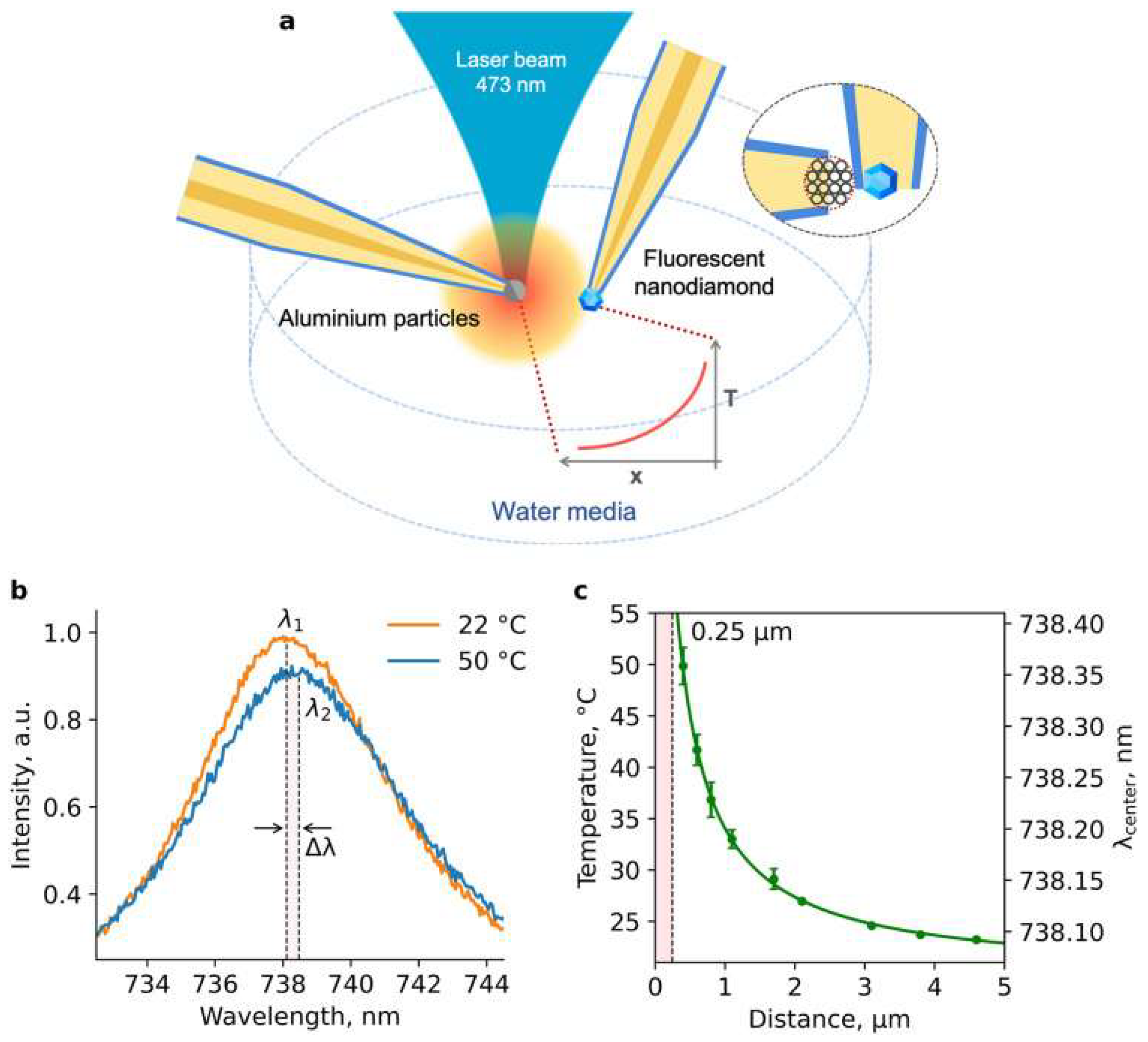
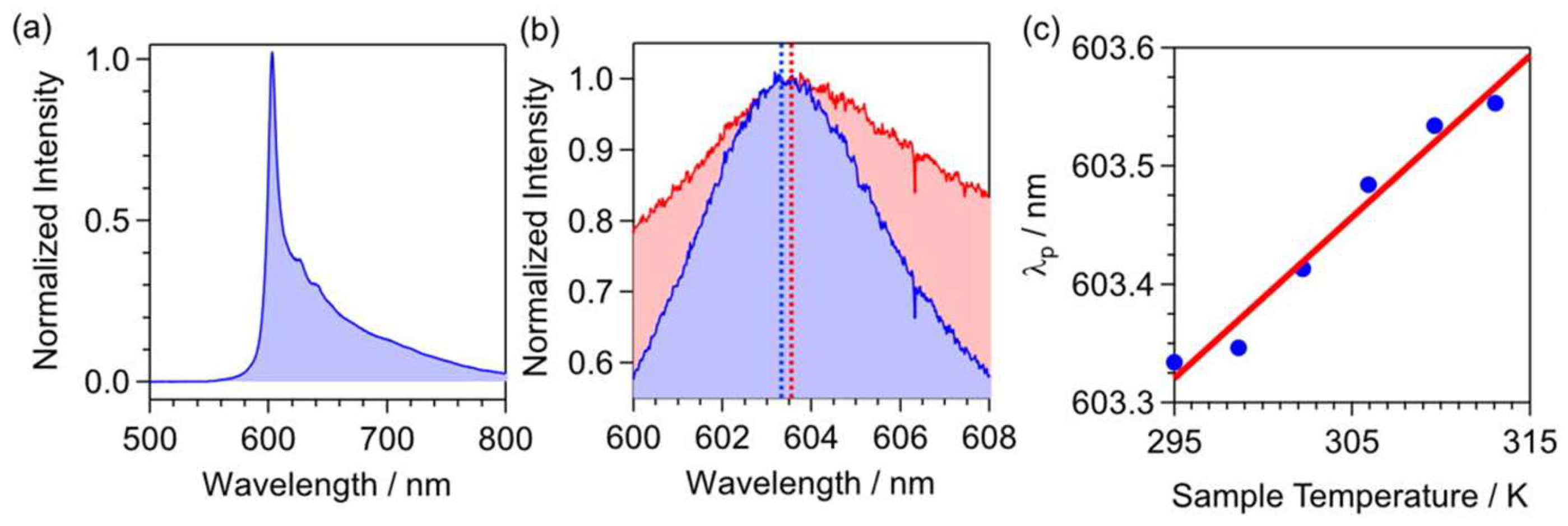
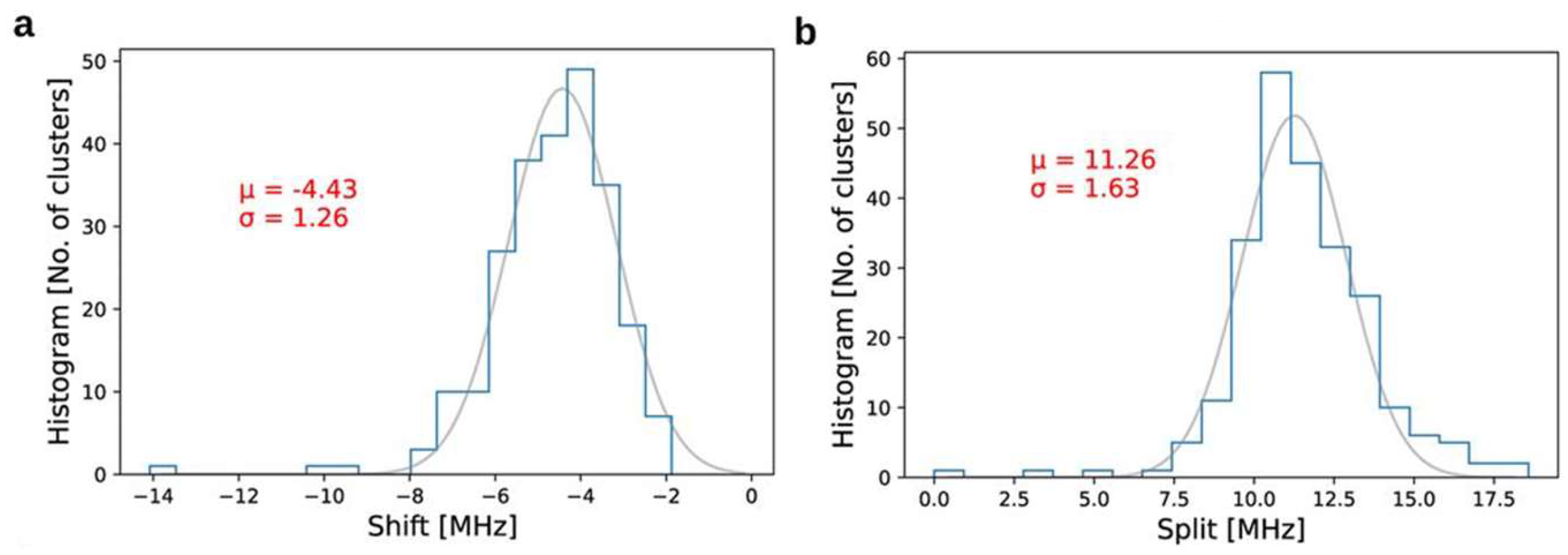
| Color Center | Size, nm | Type | Measurement Method | Bio Tests | Temperature Range, °C | Sensitivity, K Hz−1/2. | Ref. |
|---|---|---|---|---|---|---|---|
| NV | 100 ± 50 | ND in PHEMA film | ZPL shift, Ensemble | No | 35–120 | 0.15–1.1 | [39] |
| NV | 35 | HPHT milled ND, carboxylated surface | ZPL shift | No | 25–60 | – | [40] |
| NV | 70 | HPHT milled ND, polyfunctional surface groups | ZPL shift | No | 25–60 | – | [40] |
| NV | 100 | HPHT milled ND, hydroxylated surface | ZPL shift | Yes | 25–60 | – | [40] |
| NV | 100 | Cationic surface, attached to gold nanorods | ZPL shift | Yes | 28–75 | 2 | [41] |
| NV | 100 ± 30 | Aggregated ND to microspheres | ZPL shift | Yes | 20–60 | 0.5 | [42] |
| NV | 50 | Milled ND | ZPL intensity | No | 22–110 | 0.3 | [43] |
| NV | 50 | Milled ND in polyvinyl alcohol | ODMR shift | No | 22–40 | 0.13 | [44] |
| NV | 50 | Milled ND | ODMR shift | Yes | 20–30 | 0.009 | [45] |
| NV | 100 | Milled ND, carboxylated surface | ODMR shift | Yes | 33–36 | 1.5 | [46] |
| NV | – | Milled ND | ODMR shift | Yes | 27–37 | – | [47] |
| NV | 185 | Milled ND | ODMR shift | Yes | 28–38 | 3 | [48] |
| NV | 40 ± 15 | HPHP milled ND in a cross-linked nanogel | ODMR shift | Yes | 20–50 | 0.6 | [35] |
| NV | 20,000–30,000 | Microdiamond on an optical fiber | ODMR shift | Yes | 22–36 | – | [49] |
| NV | 100 | Milled ND, carboxylated surface | ODMR shift | Yes | 25–45 | 1.4 | [50] |
| NV | 11 | Detonation ND | ODMR shift | No | 22–42 | 0.36 | [51] |
| SiV | 200 ± 70 | HPHP ND | ZPL shift | No | 22–42 | 0.521 | [52] |
| SiV | 50 | HPHT ND with HSA coating | ZPL shift | Yes | 25–38 | – | [53] |
| SiV | 500 | CVD ND on an optical fiber | ZPL shift | No | 20–150 | – | [54] |
| SiV | 500 | CVD ND on an optical fiber | ZPL shift | Yes | 23–45 | – | [55] |
| GeV | – | HPHT ND | ZPL shift | No | −125–125 | 0.3 | [56] |
| GeV | 30 ± 10 | Detonation ND | ZPL shift | No | 22–40 | 1 | [57] |
Disclaimer/Publisher’s Note: The statements, opinions and data contained in all publications are solely those of the individual author(s) and contributor(s) and not of MDPI and/or the editor(s). MDPI and/or the editor(s) disclaim responsibility for any injury to people or property resulting from any ideas, methods, instructions or products referred to in the content. |
© 2024 by the author. Licensee MDPI, Basel, Switzerland. This article is an open access article distributed under the terms and conditions of the Creative Commons Attribution (CC BY) license (https://creativecommons.org/licenses/by/4.0/).
Share and Cite
Ermakova, A. Fluorescent Nanodiamonds for High-Resolution Thermometry in Biology. Nanomaterials 2024, 14, 1318. https://doi.org/10.3390/nano14151318
Ermakova A. Fluorescent Nanodiamonds for High-Resolution Thermometry in Biology. Nanomaterials. 2024; 14(15):1318. https://doi.org/10.3390/nano14151318
Chicago/Turabian StyleErmakova, Anna. 2024. "Fluorescent Nanodiamonds for High-Resolution Thermometry in Biology" Nanomaterials 14, no. 15: 1318. https://doi.org/10.3390/nano14151318





